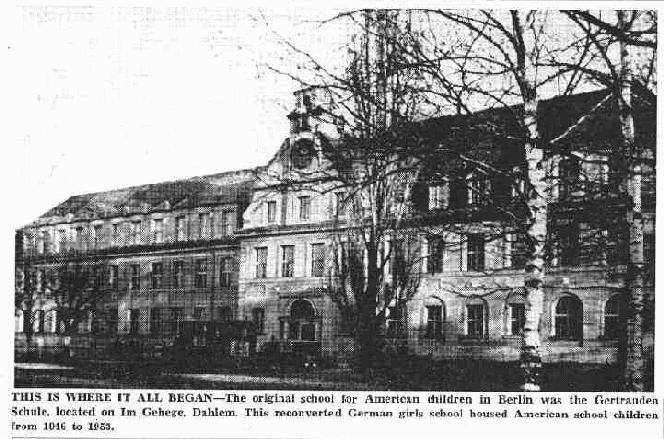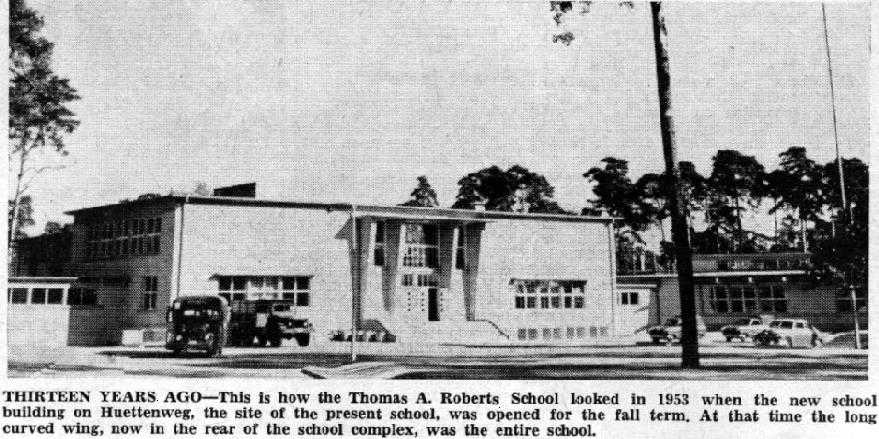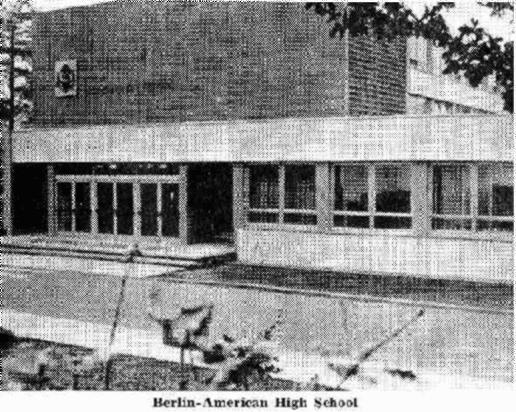US Dependent Schools Celebrate Founding; Classes Began in 1946
|
|
From humble beginnings in converted
German schools, troop barracks and
private homes, to the present day 55
million dollar annual investment in
education; that is the story of the U.S.
Dependents School, European area, which
celebrates its 20th anniversary today.
The dependents school system began from
scratch in 1945 amid the rubble of war-
torn Europe. Actual school operations
began on October 14, 1946, when 88
elementary schools and five high schools
opened their doors to 2,800 American
children and 120 teachers. Events,
clearly chronicled in today's history
books, brought this situation about.
Hundreds of thousands of troops stayed
for occupation duty in Europe and began
restoring facilities and installations.
Soon wives began to arrive to join
their husbands. With them came
children, first by the hundreds, then by
the thousands. Overnight it became
necessary to open schools. In United
States history there was no precedent
for establishing a dependents
educational system in a former enemy
country occupied following victory in
war.
|

RECONVERTED GIRL'S SCHOOL
The original school for American children in
Berlin was the Gertrauden Schule, located on Im
Gehege, Dahlem, a well-known German girls school.
In 1946 the school was renamed the Thomas A.
Roberts School, in honor of the lieutenant colonel
of that name, the first American to lose his life
in the Battle of Berlin. For seven years the for
mer Gertrauden Schule provided both elementary and
high school facilities for American dependents in
Berlin.
|
|
Then in 1953 the new Thomas A. Roberts
School was opened on Huettenweg, near
the American headquarters. The general
provision for dependents schools,
published by Headquarters, U.S. Forces,
European Theater in Frankfurt, Germany,
authorized the establishment of military
schools in "every community where
enrollment justifies such action." High
schools were to be established in major
U. S. occupation centers. The Dependents
School Service; a staff agency of Army
theater headquarters, was created to
administer the school system. The
original staff consisted of two
officers, one enlisted man and four
civilians, a librarian, a science
specialist, a music specialist and a
secondary education specialist. Teachers
recruited in the United States under
two-year contracts, a number of wives of
occupation personnel with teaching
experience and some German language
teachers, were at first, hired to staff
the dependent schools. The first year of
operation of the Thomas A. Roberts
School saw a total enrollment of 60
students and a faculty of 20, - 12
Americans and 8 Germans. By 1947 the
enrollment had jumped to 107. The
blockade of 1948-49 forced enrollment
down to 22 students in 1948. As an
interesting note, in 1947, a polio
epidemic forced the school to close down
and classes were conducted through
AFN-Berlin.
|

|
|
By 1953, the TAR school had a total
enrollment of 146. students. To day, the
TAR enrollment stands at 1,450 students
and 55 teachers. The Berlin-American
High School student body comprises 612
pupils with a teaching staff of 34.
Throughout the system, enrollment stood
at 3,100 in Army schools in 1947,
increased to 6,800 during 1949-50 school
year and, with the opening of US Air
Force Schools in 1953, the combined
enrollment zoomed to 21,900. Enrollment
continued to increase with each year,
reaching new peaks of 35,576 in 1956-57
and a total of 41,097 in 1957-58.
Today, more than 5,000 professional
educators are employed under the program
to provide education for an estimated
100,000 children in some 245 schools
throughout 1 6 countries in Europe,
North Africa and the Middle East.
Money and Supplies
In the early days, schools operated on
nonappropriated funds - profits from the
officer's and non- commissioned
officer's open messes, and in some
cases, small tuition fees. Supplies were
obtained anywhere they could be found.
The Signal Corps made available films,
film strips and audio visual aids. The
Quartermaster provided paper,
note-books, pencils, ink, brooms, mops
and- perhaps even a kitchen sink for the
chemistry lab. Some laboratory equipment
was made available by the Medical Corps.
In 1953 in Berlin, teachers, students
and school equipment were moved from the
former German girls School to the new
school building on Huettenweg the site
of the present Thomas A. Roberts School.
At that time the long curved wing, now
in the rear of the school complex, was
the entire school. Brigadier General
Charles F. Craig, then commanding
general, Berlin Command, cut the ribbon
September 9, 1953, for the opening of
the new school, as a group of 110
school-children and nine faculty members
streamed into the new, modern site to
begin the school sea- son's scholastic
activities.
New School Building
Miss Velma J. Reilly, then school
principal, commenting on the school's
new building, said she found it a "very
wonderful, modern, fully equipped
building" and that she believed the
children would be happy there. Miss
Reilly further added that the school was
equal in all aspects and in some cases
superior to stateside schools, boasting
at least four teachers who held Master
of Arts degrees. One student at the time
thought that the building was "much
nicer than the old one." Another said "I
think the new building is fine. I like
it because we don't have so many stairs
to walk up and down. I like I the
principal better than the man principal
because she's nicer to us." Brigadier
General George T. Duncan, then
commanding general, Berlin Command,
dedicated the new center wing addition
to the TAR school in December of 1957.
The final building phase was completed
in September of 1960. The new wing, the
front wing of the school, houses 11
classrooms, two cafeterias and some
special subject rooms. The new look was
given a stamp of approval during a
formal inspection undertaken August 19,
1960, by Lieutenant Colonel Lawrence
Vogel, then Berlin Command Engineer. In
all, a total of $1,132,200 has been
spent to build and expand the Thomas A.
Roberts School.
|
|
From its beginning, the Thomas A. Roberts School had accommodated both an elementary school and a high school. The increased number of school age dependents in Berlin made it apparent that a self contained high school was a necessity. Major General James H. Polk, then U.S. Commander, Berlin, broke ground on the site of this new high school in May of 1964. Major General John F. Franklin Jr., U.S. Commander, Berlin, and Brigadier General John H. Hay, then commanding general, Berlin Brigade, cut the ribbon to officially open the new Berlin-American High School on August 25, 1965, before a gathering of German and American guests. In his speech dedicating the new high school, General Franklin called the " magnificent " two-million-dollar structure a symbol of the " tremendous improvement in basic educational facilities " and of " dedication to hard work. " Approximately 580 students in grades 7 through 12 enrolled for the 1965-66 school term. Many of the classrooms in the new high school featured sliding walls so that classes could be broken down into various sizes to suit the occasion. The school library holds 7,000 volumes, 3,000 magazines, 300 record albums and 600 film strips. The school contains 26 general purpose classrooms, rooms for arts and crafts, home economics, mechanical drawing, general science, music, biology, physics, chemistry, industrial arts and typing. It is expected that the cafeteria at the high school will be completed within the next few weeks and that the gym will be finished not later than December 1, 1966
|

|
|
When asked about the education offered American students at the high school, Principal Paul F. LeBrun commented that "the school offers an education comparable to that offered in the better high schools in the United States. The facilities are modern and in fact the high school could be transported to an American community in the States. The curriculum is the same as offered at any comprehensive American high school. Whether the students wish to go to college or work after their high schooling, the school's counseling program will enable them to choose the correct program. Staff wise, the teachers are all experienced and all certified. The average experience of our teachers is eight years, with none less than two." The same question prompted Helen J. Brady, principal of the Thomas A. Roberts School to state that "the education here compares with any good elementary school in the United States; The TAR school is well-supported, well-equipped and maintains an excellent staff." Since the high school opened in 1965, the TAR school has under gone many changes in the area formerly occupied by the high school. Many rooms, including a former home economics room and a former science area have been converted into classrooms. A music room for TAR students was provided by modifying two former high school classrooms. The present building contains 46 classrooms, a gym, a music room, a library, a reading room and an audio-visual room. At the present time the faculty of the Berlin-American High School is at work on establishing the curriculum for the comprehensive American high school program which is in its initial stages at the German-American John F. Kennedy School. Eager to keep up with the new teaching methods, the high school will in a few weeks launch an attempt to teach advanced mathematics with calculators as a teaching tool. It is hoped the calculators will increase students interest in advanced math and help them concentrate on the higher workings of mathematics. This will be the first time that a dependent school has attempted-this experiment.
Further Academic Study
The regular curriculum at both the TAR school and the Berlin- American High School puts a strong emphasis on fundamentals in the elementary grades and on college preparation in the high schools.
"Principal LeBrun stated that 85 percent of the Berlin-American high school students go on to further academic study in college. The achievement of children in the dependents school system is above the national standards in every elementary grade and in every high school subject for which standard tests are given. Physical education makes its contribution to the total curriculum through its supervised programs of conditioning, sports, recreational games, and leadership training. At the present time the high school football team is undefeated this year.
The faculty at the Thomas A. Roberts School and the Berlin-American High School believes that each child should be looked upon, and accepted, as an individual entitled to educational opportunities which will challenge him to become a mature, thinking and contributing member of his free society; to help prepare each for a satisfying personal life and social relationships; to acquaint each with our common cultural heritage; to help each to integrate the subject matter of related disciplines; to develop skills, abilities, attitudes and values which should help each to develop emotionally and morally; to develop cultural and aesthetic know ledges and to have an appreciation of other nations.
From a converted girl's school in 1946, to the original Thomas A. Roberts School, through its two expansions, to the Berlin-American High School, and the many other dependent school facilities opened throughout Europe, the 20-year story of the U. S Dependents School System, European Area, is a story of continuing progress and investment in education for the sons and daughters of U.S. Forces personnel serving in the European area.
|
|

